BSB61218 Advanced Diploma: Program Initiation & Execution Analysis
VerifiedAdded on 2022/08/15
|14
|2259
|18
Case Study
AI Summary
This document presents a comprehensive business program initiation assessment, using PWC Australia as an example for framing an executive coaching program. It details the program's background, rationale, alternatives considered, expected benefits and dis-benefits, estimated costs, investment portfolio, funding arrangements, and risk identification. The assessment further explores discussions with stakeholders, agreeing on program issues, identifying and analyzing key factors, generating scenarios, and documenting the future state. It evaluates internal and external contexts, defines the desired future state, program execution approach, and business case. The document also covers negotiation stages, policy structure, revision, documentation, program future state model creation, and the program governance model, emphasizing decision-making structures, roles, and communication within the program.
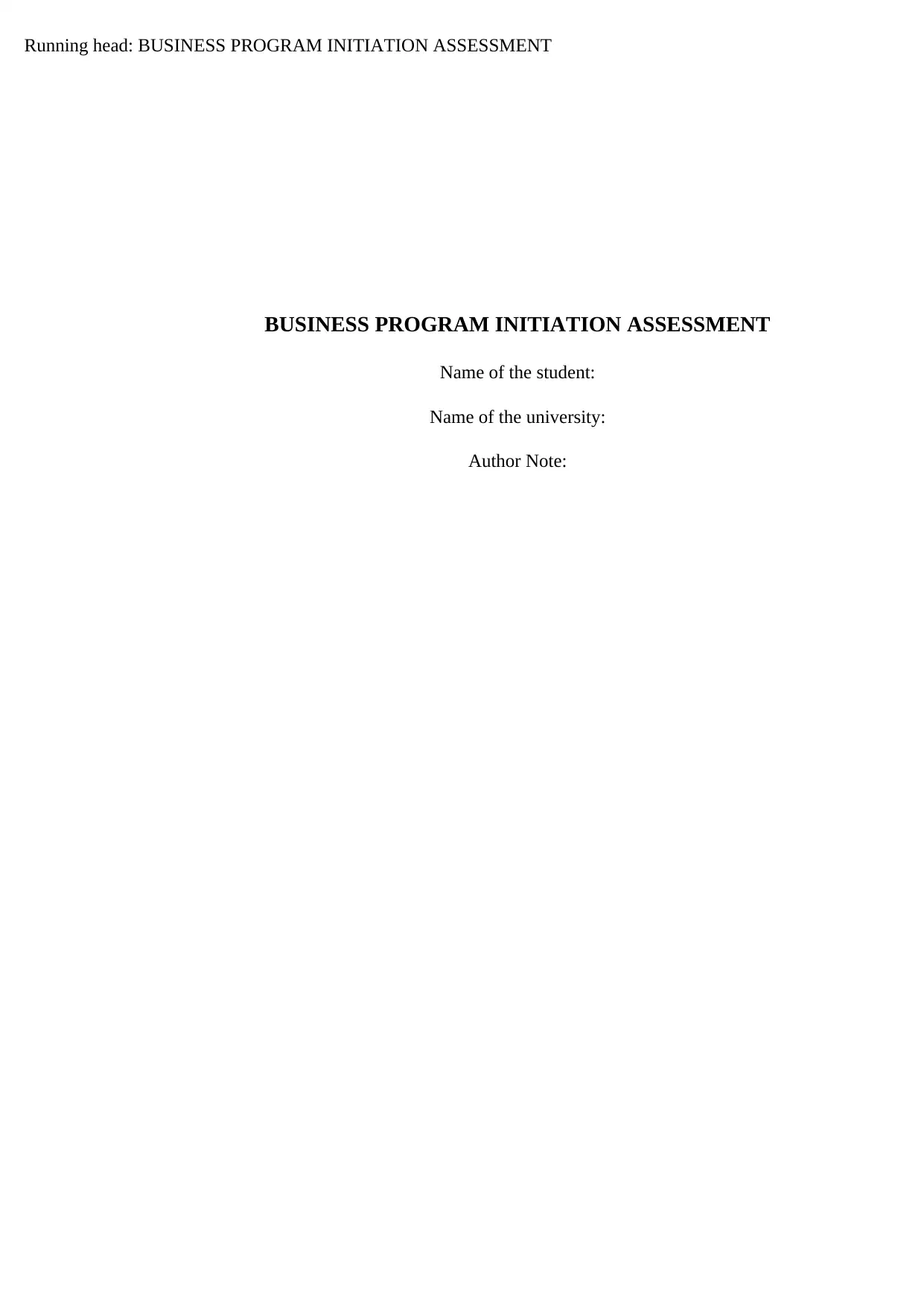
Running head: BUSINESS PROGRAM INITIATION ASSESSMENT
BUSINESS PROGRAM INITIATION ASSESSMENT
Name of the student:
Name of the university:
Author Note:
BUSINESS PROGRAM INITIATION ASSESSMENT
Name of the student:
Name of the university:
Author Note:
Paraphrase This Document
Need a fresh take? Get an instant paraphrase of this document with our AI Paraphraser
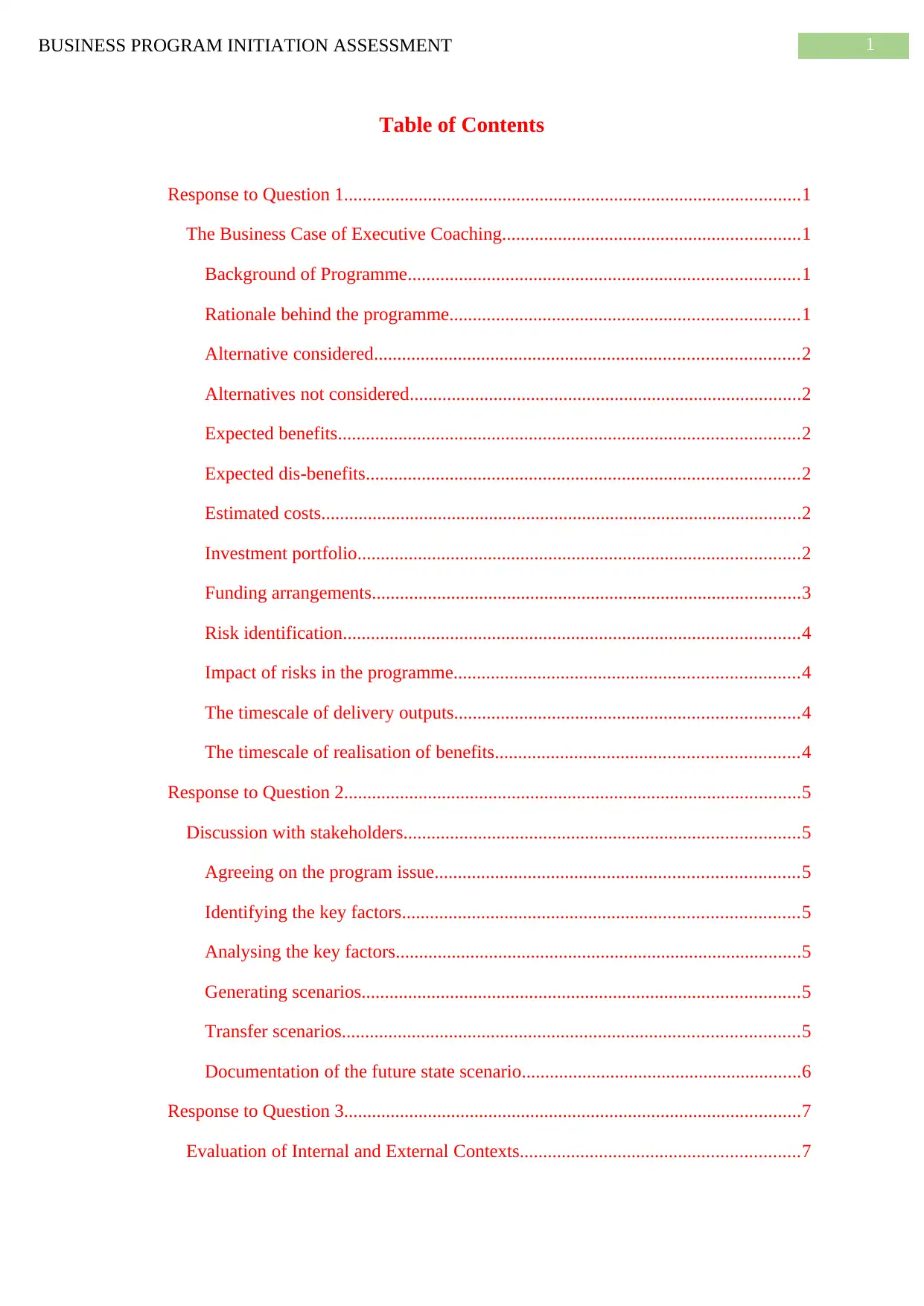
1BUSINESS PROGRAM INITIATION ASSESSMENT
Table of Contents
Response to Question 1..................................................................................................1
The Business Case of Executive Coaching................................................................1
Background of Programme....................................................................................1
Rationale behind the programme...........................................................................1
Alternative considered...........................................................................................2
Alternatives not considered....................................................................................2
Expected benefits...................................................................................................2
Expected dis-benefits.............................................................................................2
Estimated costs.......................................................................................................2
Investment portfolio...............................................................................................2
Funding arrangements............................................................................................3
Risk identification..................................................................................................4
Impact of risks in the programme..........................................................................4
The timescale of delivery outputs..........................................................................4
The timescale of realisation of benefits.................................................................4
Response to Question 2..................................................................................................5
Discussion with stakeholders.....................................................................................5
Agreeing on the program issue..............................................................................5
Identifying the key factors.....................................................................................5
Analysing the key factors.......................................................................................5
Generating scenarios..............................................................................................5
Transfer scenarios..................................................................................................5
Documentation of the future state scenario............................................................6
Response to Question 3..................................................................................................7
Evaluation of Internal and External Contexts............................................................7
Table of Contents
Response to Question 1..................................................................................................1
The Business Case of Executive Coaching................................................................1
Background of Programme....................................................................................1
Rationale behind the programme...........................................................................1
Alternative considered...........................................................................................2
Alternatives not considered....................................................................................2
Expected benefits...................................................................................................2
Expected dis-benefits.............................................................................................2
Estimated costs.......................................................................................................2
Investment portfolio...............................................................................................2
Funding arrangements............................................................................................3
Risk identification..................................................................................................4
Impact of risks in the programme..........................................................................4
The timescale of delivery outputs..........................................................................4
The timescale of realisation of benefits.................................................................4
Response to Question 2..................................................................................................5
Discussion with stakeholders.....................................................................................5
Agreeing on the program issue..............................................................................5
Identifying the key factors.....................................................................................5
Analysing the key factors.......................................................................................5
Generating scenarios..............................................................................................5
Transfer scenarios..................................................................................................5
Documentation of the future state scenario............................................................6
Response to Question 3..................................................................................................7
Evaluation of Internal and External Contexts............................................................7
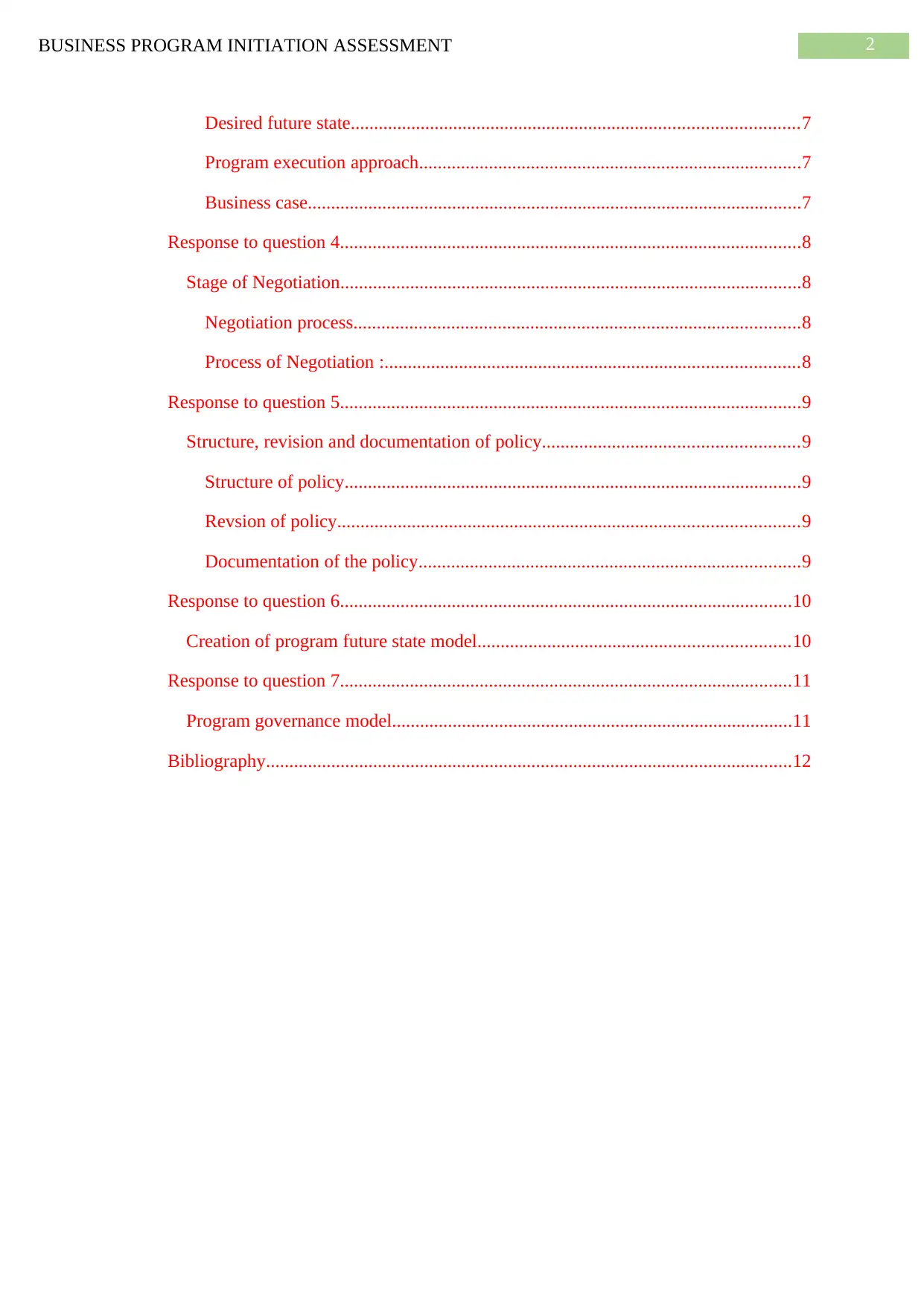
2BUSINESS PROGRAM INITIATION ASSESSMENT
Desired future state................................................................................................7
Program execution approach..................................................................................7
Business case..........................................................................................................7
Response to question 4...................................................................................................8
Stage of Negotiation...................................................................................................8
Negotiation process................................................................................................8
Process of Negotiation :.........................................................................................8
Response to question 5...................................................................................................9
Structure, revision and documentation of policy.......................................................9
Structure of policy..................................................................................................9
Revsion of policy...................................................................................................9
Documentation of the policy..................................................................................9
Response to question 6.................................................................................................10
Creation of program future state model...................................................................10
Response to question 7.................................................................................................11
Program governance model......................................................................................11
Bibliography.................................................................................................................12
Desired future state................................................................................................7
Program execution approach..................................................................................7
Business case..........................................................................................................7
Response to question 4...................................................................................................8
Stage of Negotiation...................................................................................................8
Negotiation process................................................................................................8
Process of Negotiation :.........................................................................................8
Response to question 5...................................................................................................9
Structure, revision and documentation of policy.......................................................9
Structure of policy..................................................................................................9
Revsion of policy...................................................................................................9
Documentation of the policy..................................................................................9
Response to question 6.................................................................................................10
Creation of program future state model...................................................................10
Response to question 7.................................................................................................11
Program governance model......................................................................................11
Bibliography.................................................................................................................12
⊘ This is a preview!⊘
Do you want full access?
Subscribe today to unlock all pages.

Trusted by 1+ million students worldwide
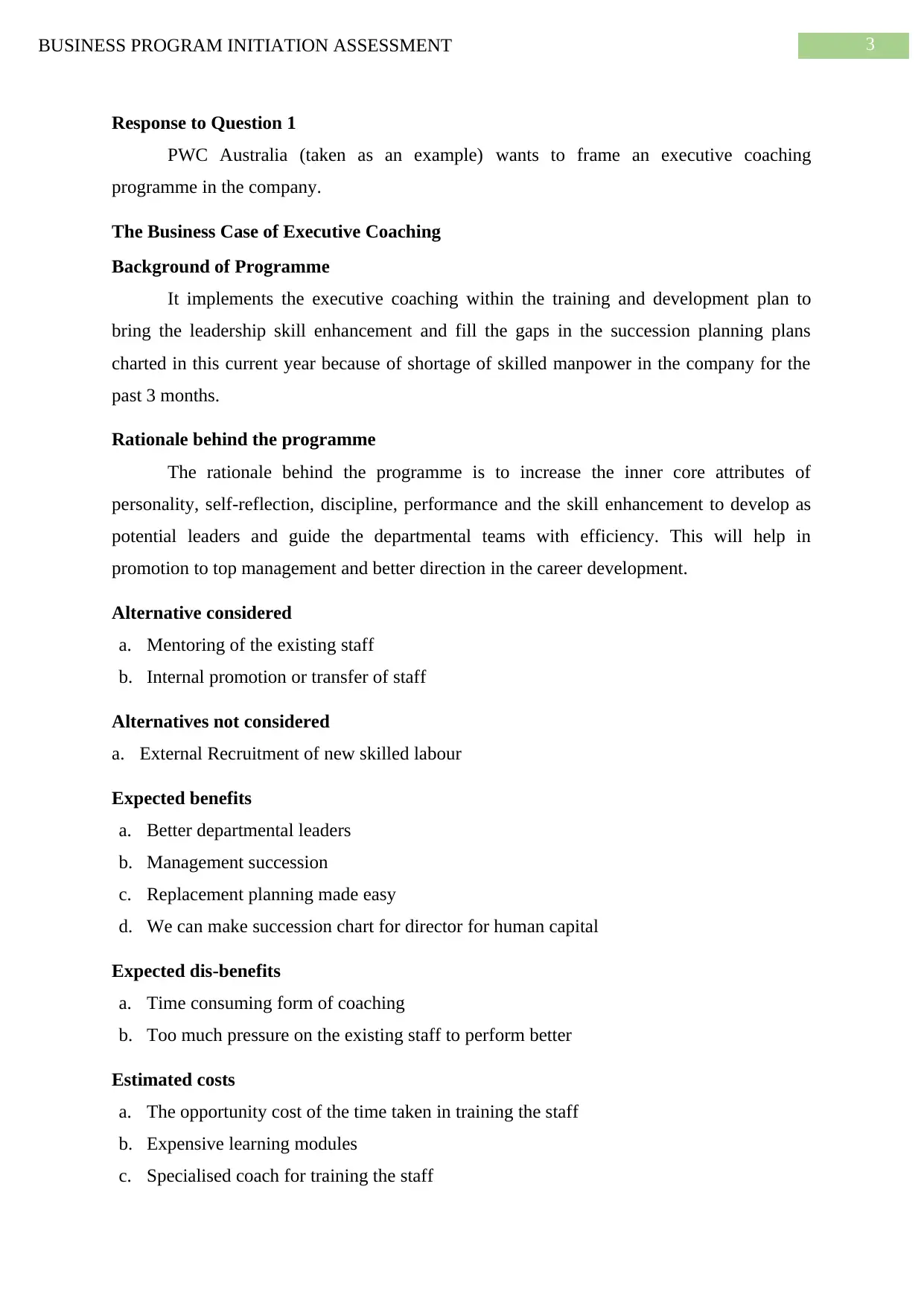
3BUSINESS PROGRAM INITIATION ASSESSMENT
Response to Question 1
PWC Australia (taken as an example) wants to frame an executive coaching
programme in the company.
The Business Case of Executive Coaching
Background of Programme
It implements the executive coaching within the training and development plan to
bring the leadership skill enhancement and fill the gaps in the succession planning plans
charted in this current year because of shortage of skilled manpower in the company for the
past 3 months.
Rationale behind the programme
The rationale behind the programme is to increase the inner core attributes of
personality, self-reflection, discipline, performance and the skill enhancement to develop as
potential leaders and guide the departmental teams with efficiency. This will help in
promotion to top management and better direction in the career development.
Alternative considered
a. Mentoring of the existing staff
b. Internal promotion or transfer of staff
Alternatives not considered
a. External Recruitment of new skilled labour
Expected benefits
a. Better departmental leaders
b. Management succession
c. Replacement planning made easy
d. We can make succession chart for director for human capital
Expected dis-benefits
a. Time consuming form of coaching
b. Too much pressure on the existing staff to perform better
Estimated costs
a. The opportunity cost of the time taken in training the staff
b. Expensive learning modules
c. Specialised coach for training the staff
Response to Question 1
PWC Australia (taken as an example) wants to frame an executive coaching
programme in the company.
The Business Case of Executive Coaching
Background of Programme
It implements the executive coaching within the training and development plan to
bring the leadership skill enhancement and fill the gaps in the succession planning plans
charted in this current year because of shortage of skilled manpower in the company for the
past 3 months.
Rationale behind the programme
The rationale behind the programme is to increase the inner core attributes of
personality, self-reflection, discipline, performance and the skill enhancement to develop as
potential leaders and guide the departmental teams with efficiency. This will help in
promotion to top management and better direction in the career development.
Alternative considered
a. Mentoring of the existing staff
b. Internal promotion or transfer of staff
Alternatives not considered
a. External Recruitment of new skilled labour
Expected benefits
a. Better departmental leaders
b. Management succession
c. Replacement planning made easy
d. We can make succession chart for director for human capital
Expected dis-benefits
a. Time consuming form of coaching
b. Too much pressure on the existing staff to perform better
Estimated costs
a. The opportunity cost of the time taken in training the staff
b. Expensive learning modules
c. Specialised coach for training the staff
Paraphrase This Document
Need a fresh take? Get an instant paraphrase of this document with our AI Paraphraser
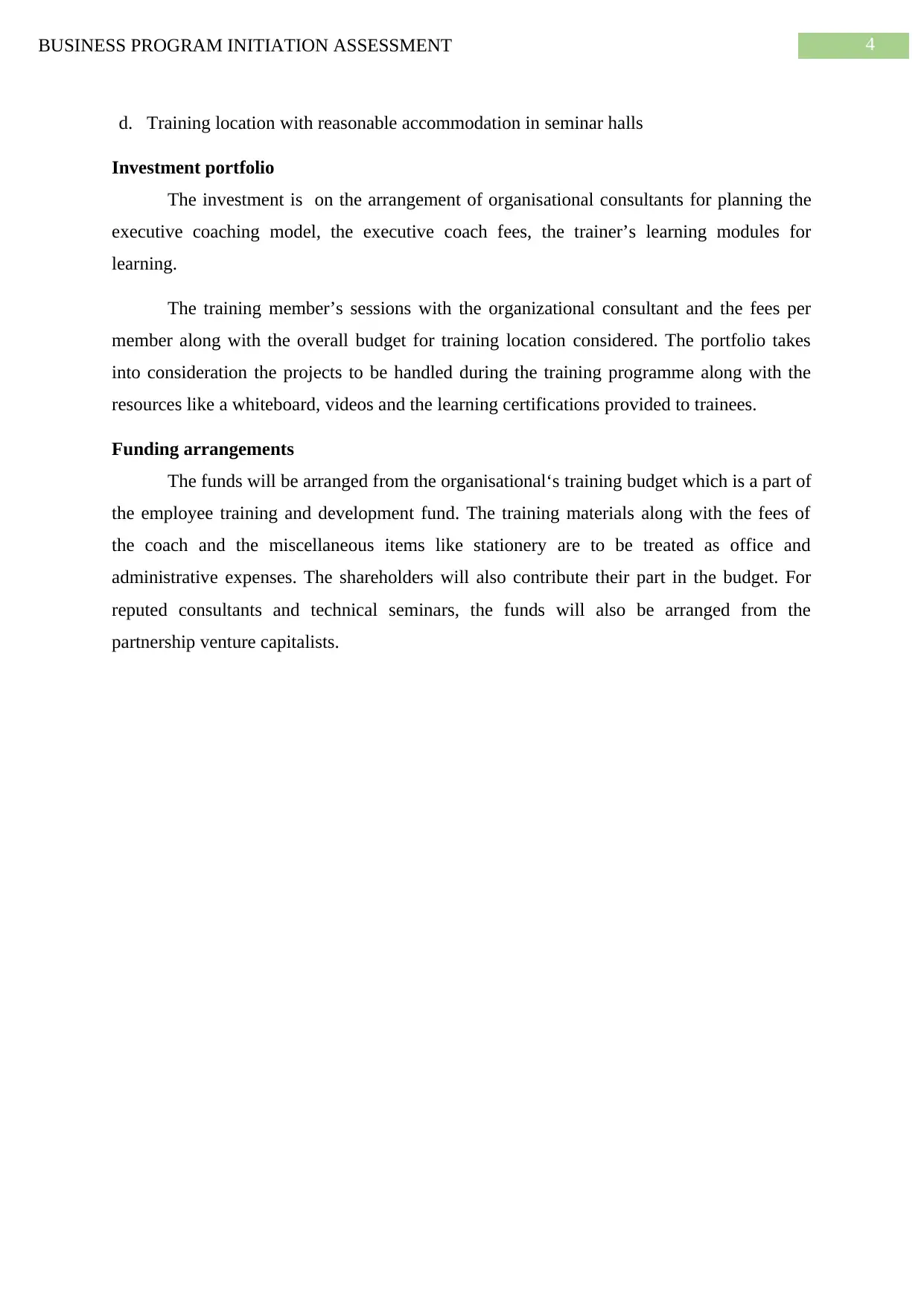
4BUSINESS PROGRAM INITIATION ASSESSMENT
d. Training location with reasonable accommodation in seminar halls
Investment portfolio
The investment is on the arrangement of organisational consultants for planning the
executive coaching model, the executive coach fees, the trainer’s learning modules for
learning.
The training member’s sessions with the organizational consultant and the fees per
member along with the overall budget for training location considered. The portfolio takes
into consideration the projects to be handled during the training programme along with the
resources like a whiteboard, videos and the learning certifications provided to trainees.
Funding arrangements
The funds will be arranged from the organisational‘s training budget which is a part of
the employee training and development fund. The training materials along with the fees of
the coach and the miscellaneous items like stationery are to be treated as office and
administrative expenses. The shareholders will also contribute their part in the budget. For
reputed consultants and technical seminars, the funds will also be arranged from the
partnership venture capitalists.
d. Training location with reasonable accommodation in seminar halls
Investment portfolio
The investment is on the arrangement of organisational consultants for planning the
executive coaching model, the executive coach fees, the trainer’s learning modules for
learning.
The training member’s sessions with the organizational consultant and the fees per
member along with the overall budget for training location considered. The portfolio takes
into consideration the projects to be handled during the training programme along with the
resources like a whiteboard, videos and the learning certifications provided to trainees.
Funding arrangements
The funds will be arranged from the organisational‘s training budget which is a part of
the employee training and development fund. The training materials along with the fees of
the coach and the miscellaneous items like stationery are to be treated as office and
administrative expenses. The shareholders will also contribute their part in the budget. For
reputed consultants and technical seminars, the funds will also be arranged from the
partnership venture capitalists.
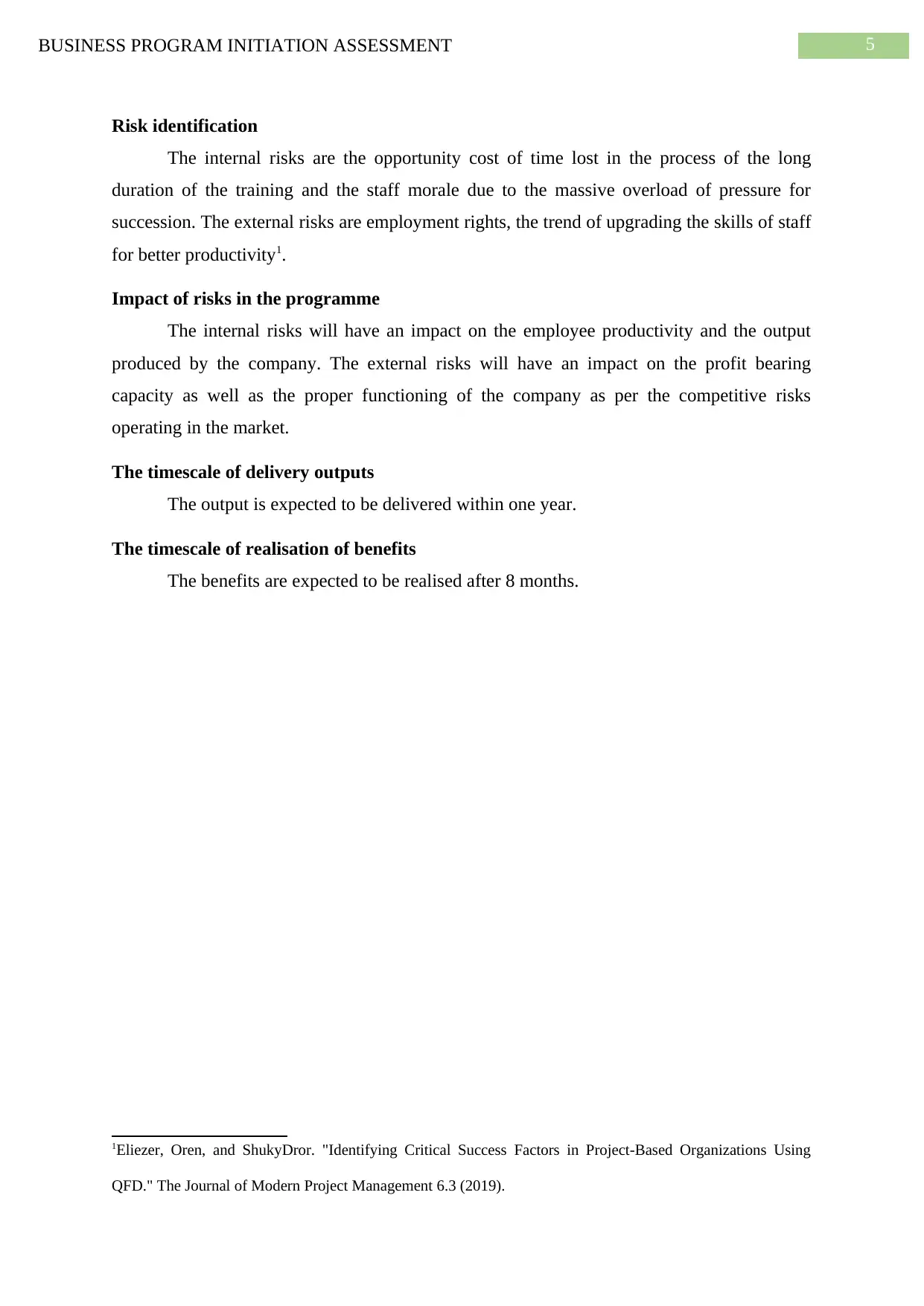
5BUSINESS PROGRAM INITIATION ASSESSMENT
Risk identification
The internal risks are the opportunity cost of time lost in the process of the long
duration of the training and the staff morale due to the massive overload of pressure for
succession. The external risks are employment rights, the trend of upgrading the skills of staff
for better productivity1.
Impact of risks in the programme
The internal risks will have an impact on the employee productivity and the output
produced by the company. The external risks will have an impact on the profit bearing
capacity as well as the proper functioning of the company as per the competitive risks
operating in the market.
The timescale of delivery outputs
The output is expected to be delivered within one year.
The timescale of realisation of benefits
The benefits are expected to be realised after 8 months.
1Eliezer, Oren, and ShukyDror. "Identifying Critical Success Factors in Project-Based Organizations Using
QFD." The Journal of Modern Project Management 6.3 (2019).
Risk identification
The internal risks are the opportunity cost of time lost in the process of the long
duration of the training and the staff morale due to the massive overload of pressure for
succession. The external risks are employment rights, the trend of upgrading the skills of staff
for better productivity1.
Impact of risks in the programme
The internal risks will have an impact on the employee productivity and the output
produced by the company. The external risks will have an impact on the profit bearing
capacity as well as the proper functioning of the company as per the competitive risks
operating in the market.
The timescale of delivery outputs
The output is expected to be delivered within one year.
The timescale of realisation of benefits
The benefits are expected to be realised after 8 months.
1Eliezer, Oren, and ShukyDror. "Identifying Critical Success Factors in Project-Based Organizations Using
QFD." The Journal of Modern Project Management 6.3 (2019).
⊘ This is a preview!⊘
Do you want full access?
Subscribe today to unlock all pages.

Trusted by 1+ million students worldwide
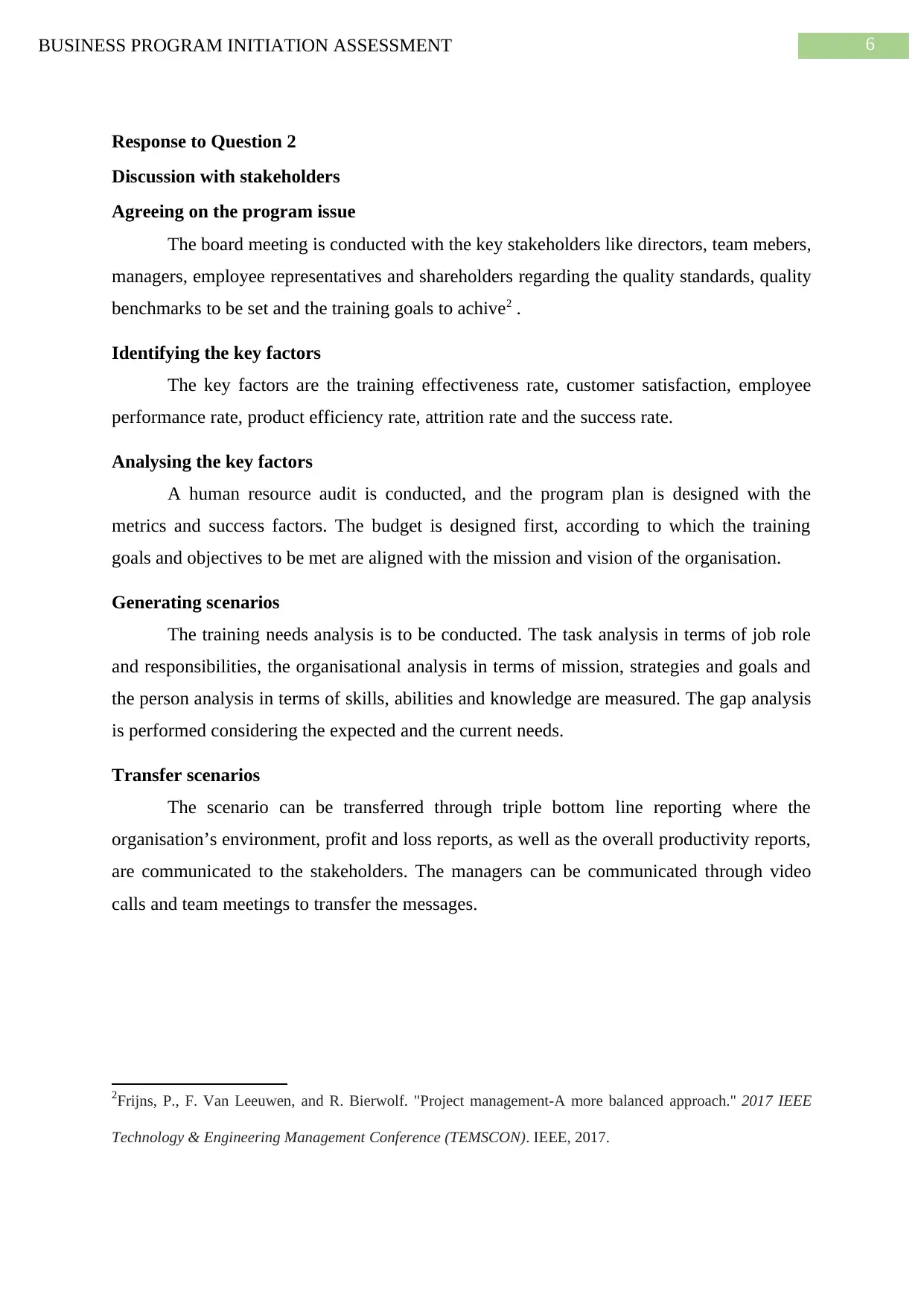
6BUSINESS PROGRAM INITIATION ASSESSMENT
Response to Question 2
Discussion with stakeholders
Agreeing on the program issue
The board meeting is conducted with the key stakeholders like directors, team mebers,
managers, employee representatives and shareholders regarding the quality standards, quality
benchmarks to be set and the training goals to achive2 .
Identifying the key factors
The key factors are the training effectiveness rate, customer satisfaction, employee
performance rate, product efficiency rate, attrition rate and the success rate.
Analysing the key factors
A human resource audit is conducted, and the program plan is designed with the
metrics and success factors. The budget is designed first, according to which the training
goals and objectives to be met are aligned with the mission and vision of the organisation.
Generating scenarios
The training needs analysis is to be conducted. The task analysis in terms of job role
and responsibilities, the organisational analysis in terms of mission, strategies and goals and
the person analysis in terms of skills, abilities and knowledge are measured. The gap analysis
is performed considering the expected and the current needs.
Transfer scenarios
The scenario can be transferred through triple bottom line reporting where the
organisation’s environment, profit and loss reports, as well as the overall productivity reports,
are communicated to the stakeholders. The managers can be communicated through video
calls and team meetings to transfer the messages.
2Frijns, P., F. Van Leeuwen, and R. Bierwolf. "Project management-A more balanced approach." 2017 IEEE
Technology & Engineering Management Conference (TEMSCON). IEEE, 2017.
Response to Question 2
Discussion with stakeholders
Agreeing on the program issue
The board meeting is conducted with the key stakeholders like directors, team mebers,
managers, employee representatives and shareholders regarding the quality standards, quality
benchmarks to be set and the training goals to achive2 .
Identifying the key factors
The key factors are the training effectiveness rate, customer satisfaction, employee
performance rate, product efficiency rate, attrition rate and the success rate.
Analysing the key factors
A human resource audit is conducted, and the program plan is designed with the
metrics and success factors. The budget is designed first, according to which the training
goals and objectives to be met are aligned with the mission and vision of the organisation.
Generating scenarios
The training needs analysis is to be conducted. The task analysis in terms of job role
and responsibilities, the organisational analysis in terms of mission, strategies and goals and
the person analysis in terms of skills, abilities and knowledge are measured. The gap analysis
is performed considering the expected and the current needs.
Transfer scenarios
The scenario can be transferred through triple bottom line reporting where the
organisation’s environment, profit and loss reports, as well as the overall productivity reports,
are communicated to the stakeholders. The managers can be communicated through video
calls and team meetings to transfer the messages.
2Frijns, P., F. Van Leeuwen, and R. Bierwolf. "Project management-A more balanced approach." 2017 IEEE
Technology & Engineering Management Conference (TEMSCON). IEEE, 2017.
Paraphrase This Document
Need a fresh take? Get an instant paraphrase of this document with our AI Paraphraser
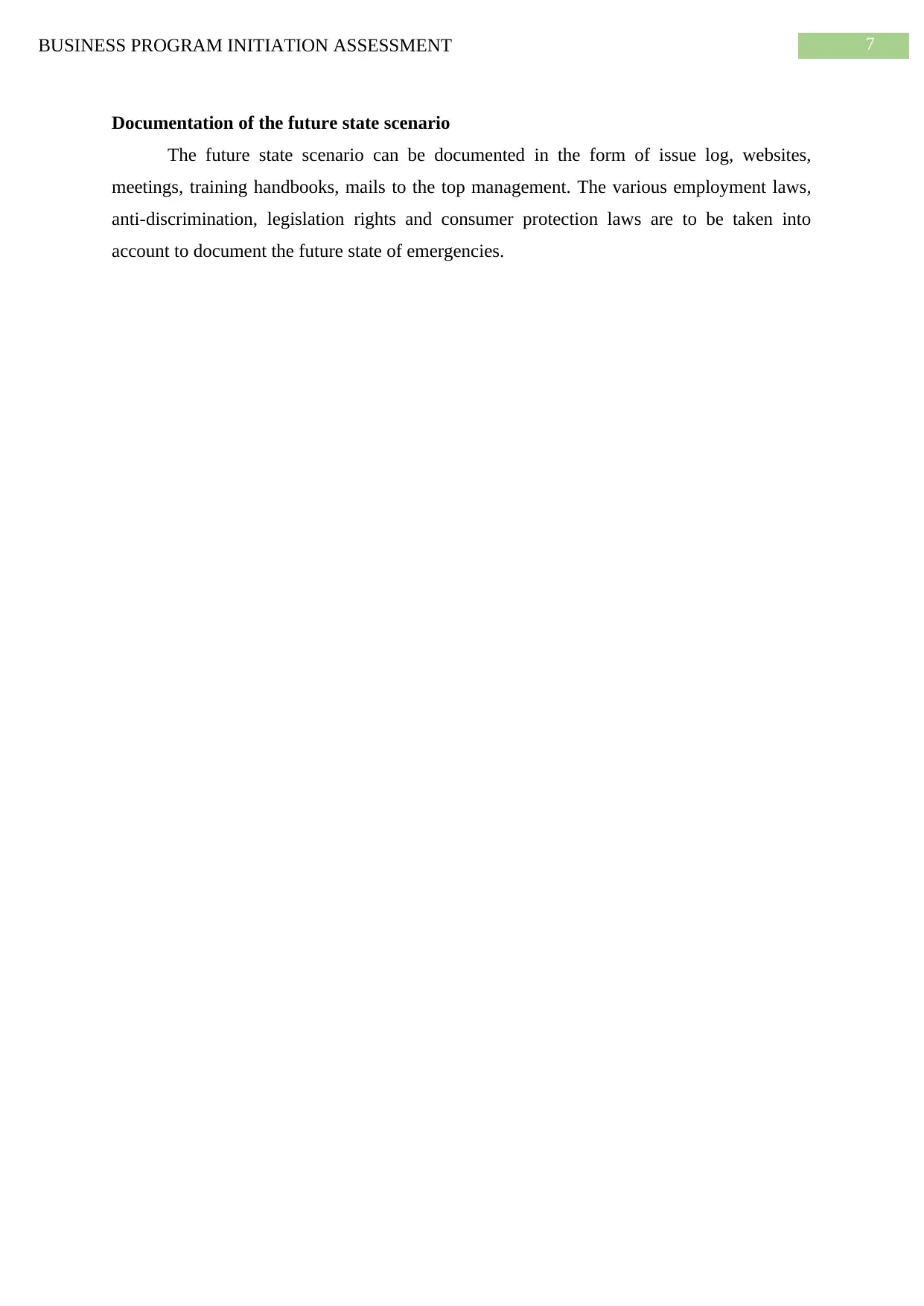
7BUSINESS PROGRAM INITIATION ASSESSMENT
Documentation of the future state scenario
The future state scenario can be documented in the form of issue log, websites,
meetings, training handbooks, mails to the top management. The various employment laws,
anti-discrimination, legislation rights and consumer protection laws are to be taken into
account to document the future state of emergencies.
Documentation of the future state scenario
The future state scenario can be documented in the form of issue log, websites,
meetings, training handbooks, mails to the top management. The various employment laws,
anti-discrimination, legislation rights and consumer protection laws are to be taken into
account to document the future state of emergencies.
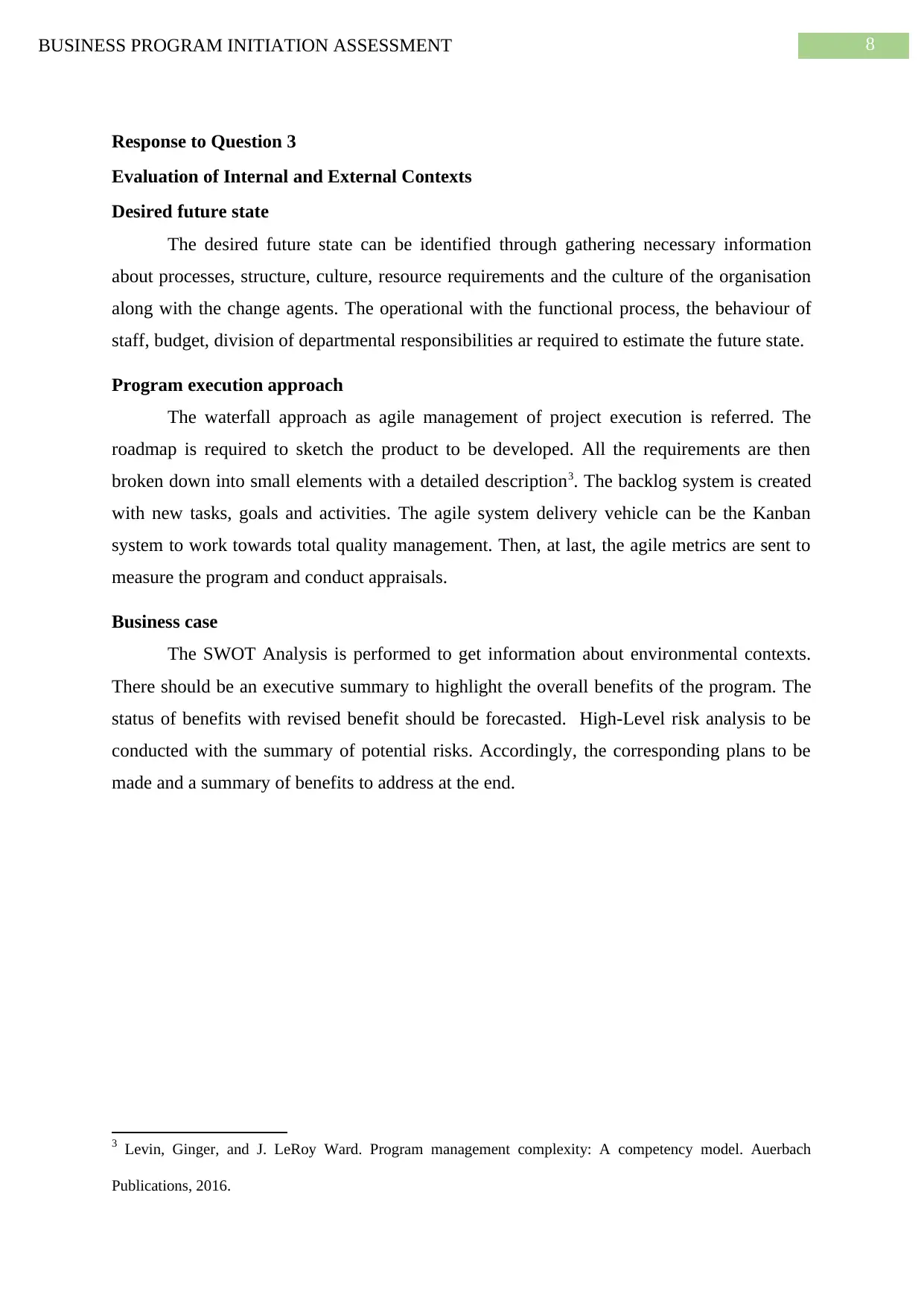
8BUSINESS PROGRAM INITIATION ASSESSMENT
Response to Question 3
Evaluation of Internal and External Contexts
Desired future state
The desired future state can be identified through gathering necessary information
about processes, structure, culture, resource requirements and the culture of the organisation
along with the change agents. The operational with the functional process, the behaviour of
staff, budget, division of departmental responsibilities ar required to estimate the future state.
Program execution approach
The waterfall approach as agile management of project execution is referred. The
roadmap is required to sketch the product to be developed. All the requirements are then
broken down into small elements with a detailed description3. The backlog system is created
with new tasks, goals and activities. The agile system delivery vehicle can be the Kanban
system to work towards total quality management. Then, at last, the agile metrics are sent to
measure the program and conduct appraisals.
Business case
The SWOT Analysis is performed to get information about environmental contexts.
There should be an executive summary to highlight the overall benefits of the program. The
status of benefits with revised benefit should be forecasted. High-Level risk analysis to be
conducted with the summary of potential risks. Accordingly, the corresponding plans to be
made and a summary of benefits to address at the end.
3 Levin, Ginger, and J. LeRoy Ward. Program management complexity: A competency model. Auerbach
Publications, 2016.
Response to Question 3
Evaluation of Internal and External Contexts
Desired future state
The desired future state can be identified through gathering necessary information
about processes, structure, culture, resource requirements and the culture of the organisation
along with the change agents. The operational with the functional process, the behaviour of
staff, budget, division of departmental responsibilities ar required to estimate the future state.
Program execution approach
The waterfall approach as agile management of project execution is referred. The
roadmap is required to sketch the product to be developed. All the requirements are then
broken down into small elements with a detailed description3. The backlog system is created
with new tasks, goals and activities. The agile system delivery vehicle can be the Kanban
system to work towards total quality management. Then, at last, the agile metrics are sent to
measure the program and conduct appraisals.
Business case
The SWOT Analysis is performed to get information about environmental contexts.
There should be an executive summary to highlight the overall benefits of the program. The
status of benefits with revised benefit should be forecasted. High-Level risk analysis to be
conducted with the summary of potential risks. Accordingly, the corresponding plans to be
made and a summary of benefits to address at the end.
3 Levin, Ginger, and J. LeRoy Ward. Program management complexity: A competency model. Auerbach
Publications, 2016.
⊘ This is a preview!⊘
Do you want full access?
Subscribe today to unlock all pages.

Trusted by 1+ million students worldwide
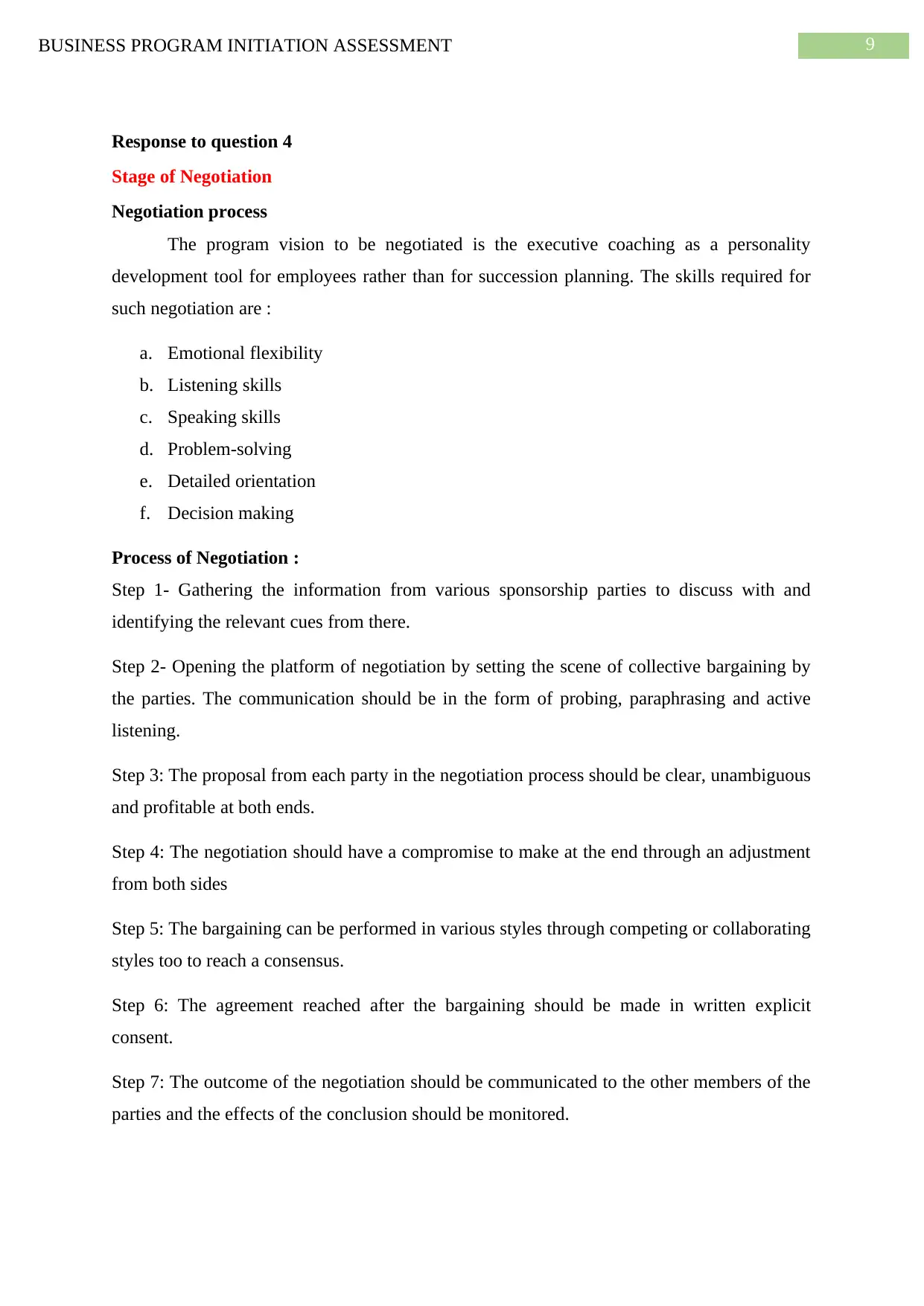
9BUSINESS PROGRAM INITIATION ASSESSMENT
Response to question 4
Stage of Negotiation
Negotiation process
The program vision to be negotiated is the executive coaching as a personality
development tool for employees rather than for succession planning. The skills required for
such negotiation are :
a. Emotional flexibility
b. Listening skills
c. Speaking skills
d. Problem-solving
e. Detailed orientation
f. Decision making
Process of Negotiation :
Step 1- Gathering the information from various sponsorship parties to discuss with and
identifying the relevant cues from there.
Step 2- Opening the platform of negotiation by setting the scene of collective bargaining by
the parties. The communication should be in the form of probing, paraphrasing and active
listening.
Step 3: The proposal from each party in the negotiation process should be clear, unambiguous
and profitable at both ends.
Step 4: The negotiation should have a compromise to make at the end through an adjustment
from both sides
Step 5: The bargaining can be performed in various styles through competing or collaborating
styles too to reach a consensus.
Step 6: The agreement reached after the bargaining should be made in written explicit
consent.
Step 7: The outcome of the negotiation should be communicated to the other members of the
parties and the effects of the conclusion should be monitored.
Response to question 4
Stage of Negotiation
Negotiation process
The program vision to be negotiated is the executive coaching as a personality
development tool for employees rather than for succession planning. The skills required for
such negotiation are :
a. Emotional flexibility
b. Listening skills
c. Speaking skills
d. Problem-solving
e. Detailed orientation
f. Decision making
Process of Negotiation :
Step 1- Gathering the information from various sponsorship parties to discuss with and
identifying the relevant cues from there.
Step 2- Opening the platform of negotiation by setting the scene of collective bargaining by
the parties. The communication should be in the form of probing, paraphrasing and active
listening.
Step 3: The proposal from each party in the negotiation process should be clear, unambiguous
and profitable at both ends.
Step 4: The negotiation should have a compromise to make at the end through an adjustment
from both sides
Step 5: The bargaining can be performed in various styles through competing or collaborating
styles too to reach a consensus.
Step 6: The agreement reached after the bargaining should be made in written explicit
consent.
Step 7: The outcome of the negotiation should be communicated to the other members of the
parties and the effects of the conclusion should be monitored.
Paraphrase This Document
Need a fresh take? Get an instant paraphrase of this document with our AI Paraphraser
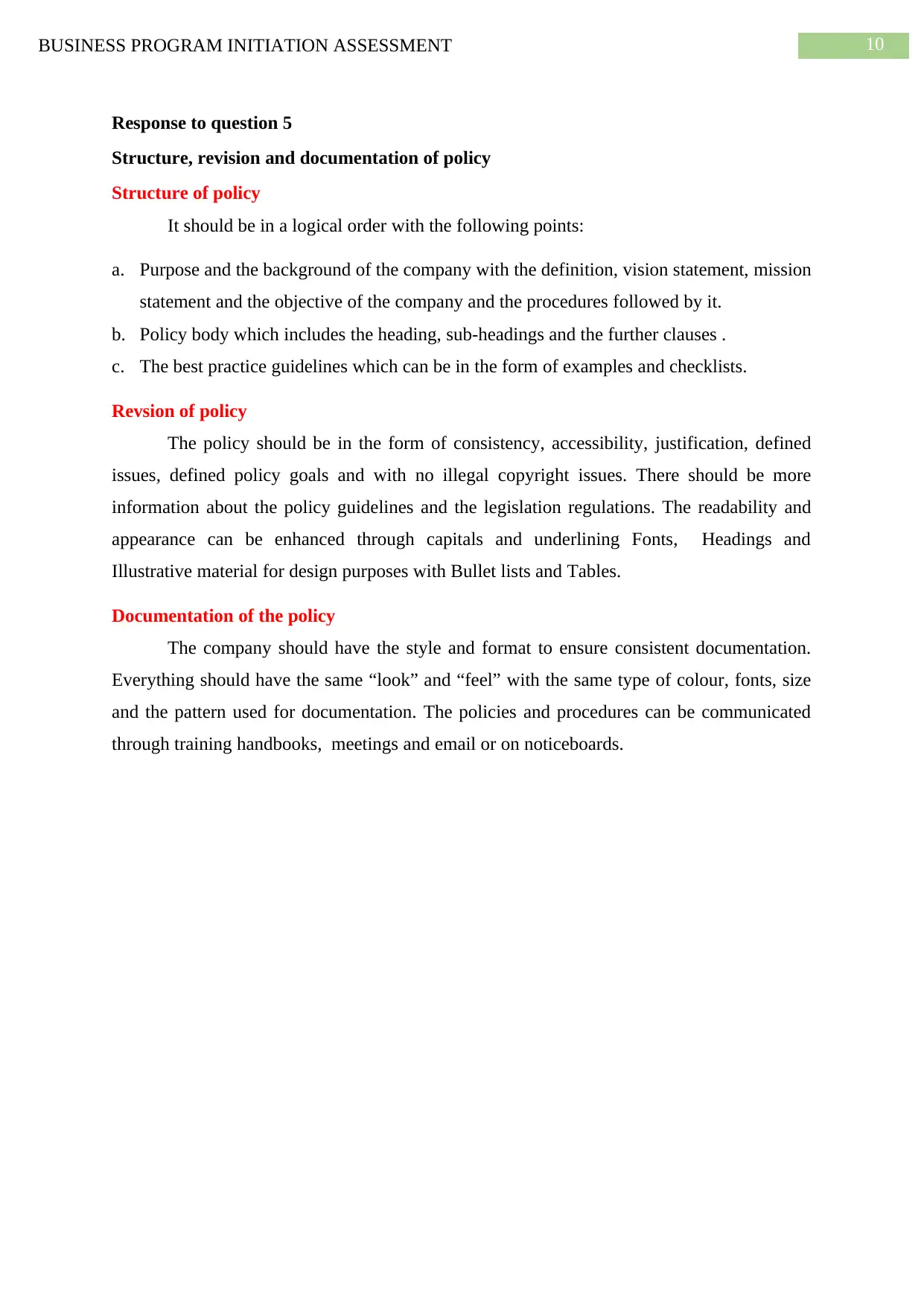
10BUSINESS PROGRAM INITIATION ASSESSMENT
Response to question 5
Structure, revision and documentation of policy
Structure of policy
It should be in a logical order with the following points:
a. Purpose and the background of the company with the definition, vision statement, mission
statement and the objective of the company and the procedures followed by it.
b. Policy body which includes the heading, sub-headings and the further clauses .
c. The best practice guidelines which can be in the form of examples and checklists.
Revsion of policy
The policy should be in the form of consistency, accessibility, justification, defined
issues, defined policy goals and with no illegal copyright issues. There should be more
information about the policy guidelines and the legislation regulations. The readability and
appearance can be enhanced through capitals and underlining Fonts, Headings and
Illustrative material for design purposes with Bullet lists and Tables.
Documentation of the policy
The company should have the style and format to ensure consistent documentation.
Everything should have the same “look” and “feel” with the same type of colour, fonts, size
and the pattern used for documentation. The policies and procedures can be communicated
through training handbooks, meetings and email or on noticeboards.
Response to question 5
Structure, revision and documentation of policy
Structure of policy
It should be in a logical order with the following points:
a. Purpose and the background of the company with the definition, vision statement, mission
statement and the objective of the company and the procedures followed by it.
b. Policy body which includes the heading, sub-headings and the further clauses .
c. The best practice guidelines which can be in the form of examples and checklists.
Revsion of policy
The policy should be in the form of consistency, accessibility, justification, defined
issues, defined policy goals and with no illegal copyright issues. There should be more
information about the policy guidelines and the legislation regulations. The readability and
appearance can be enhanced through capitals and underlining Fonts, Headings and
Illustrative material for design purposes with Bullet lists and Tables.
Documentation of the policy
The company should have the style and format to ensure consistent documentation.
Everything should have the same “look” and “feel” with the same type of colour, fonts, size
and the pattern used for documentation. The policies and procedures can be communicated
through training handbooks, meetings and email or on noticeboards.
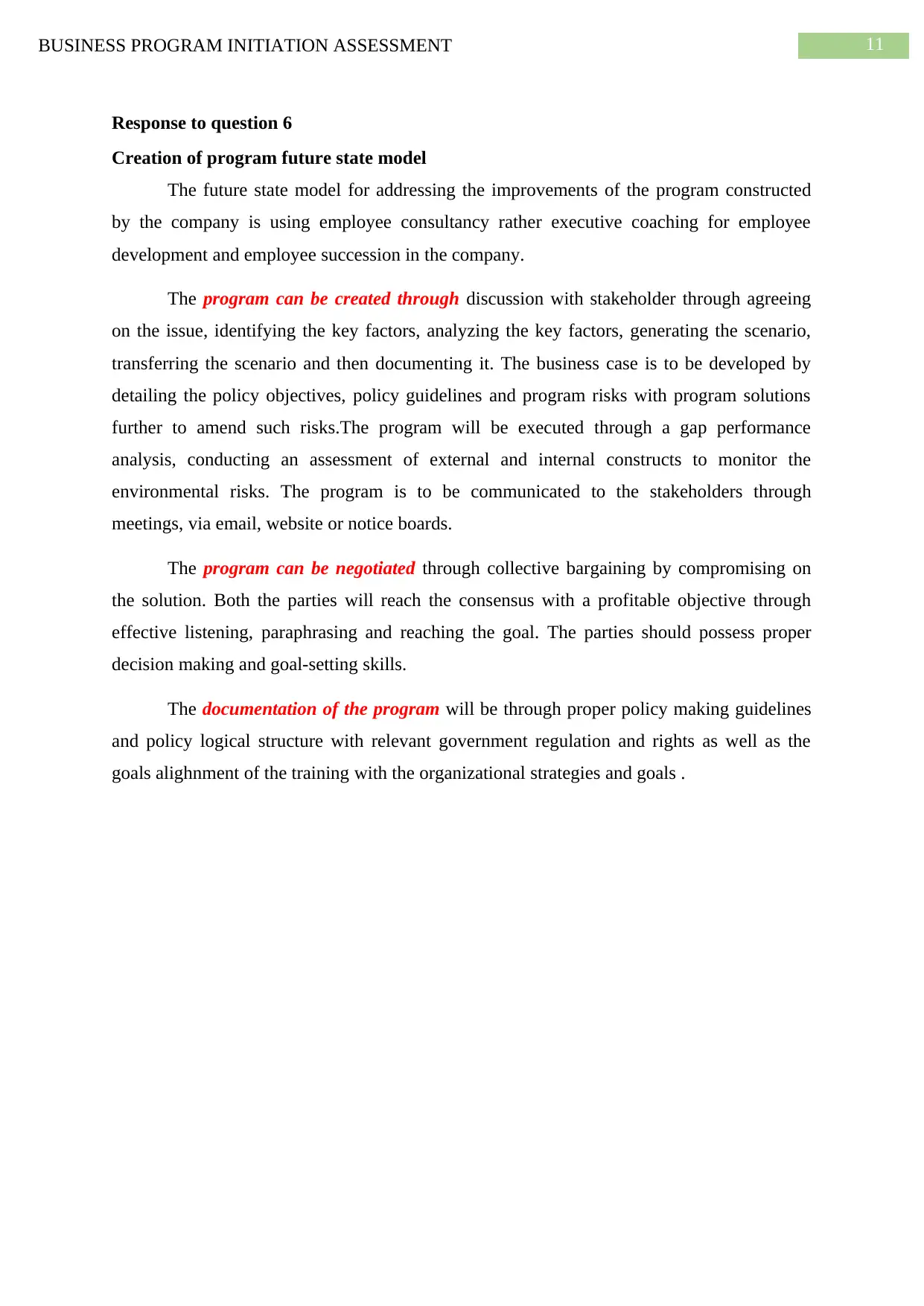
11BUSINESS PROGRAM INITIATION ASSESSMENT
Response to question 6
Creation of program future state model
The future state model for addressing the improvements of the program constructed
by the company is using employee consultancy rather executive coaching for employee
development and employee succession in the company.
The program can be created through discussion with stakeholder through agreeing
on the issue, identifying the key factors, analyzing the key factors, generating the scenario,
transferring the scenario and then documenting it. The business case is to be developed by
detailing the policy objectives, policy guidelines and program risks with program solutions
further to amend such risks.The program will be executed through a gap performance
analysis, conducting an assessment of external and internal constructs to monitor the
environmental risks. The program is to be communicated to the stakeholders through
meetings, via email, website or notice boards.
The program can be negotiated through collective bargaining by compromising on
the solution. Both the parties will reach the consensus with a profitable objective through
effective listening, paraphrasing and reaching the goal. The parties should possess proper
decision making and goal-setting skills.
The documentation of the program will be through proper policy making guidelines
and policy logical structure with relevant government regulation and rights as well as the
goals alighnment of the training with the organizational strategies and goals .
Response to question 6
Creation of program future state model
The future state model for addressing the improvements of the program constructed
by the company is using employee consultancy rather executive coaching for employee
development and employee succession in the company.
The program can be created through discussion with stakeholder through agreeing
on the issue, identifying the key factors, analyzing the key factors, generating the scenario,
transferring the scenario and then documenting it. The business case is to be developed by
detailing the policy objectives, policy guidelines and program risks with program solutions
further to amend such risks.The program will be executed through a gap performance
analysis, conducting an assessment of external and internal constructs to monitor the
environmental risks. The program is to be communicated to the stakeholders through
meetings, via email, website or notice boards.
The program can be negotiated through collective bargaining by compromising on
the solution. Both the parties will reach the consensus with a profitable objective through
effective listening, paraphrasing and reaching the goal. The parties should possess proper
decision making and goal-setting skills.
The documentation of the program will be through proper policy making guidelines
and policy logical structure with relevant government regulation and rights as well as the
goals alighnment of the training with the organizational strategies and goals .
⊘ This is a preview!⊘
Do you want full access?
Subscribe today to unlock all pages.

Trusted by 1+ million students worldwide
1 out of 14
Related Documents
Your All-in-One AI-Powered Toolkit for Academic Success.
+13062052269
info@desklib.com
Available 24*7 on WhatsApp / Email
![[object Object]](/_next/static/media/star-bottom.7253800d.svg)
Unlock your academic potential
Copyright © 2020–2025 A2Z Services. All Rights Reserved. Developed and managed by ZUCOL.





